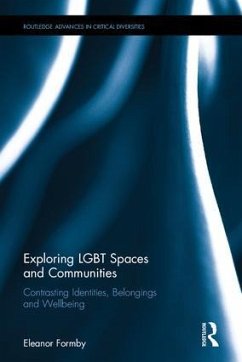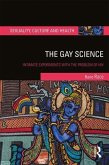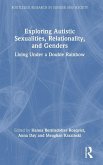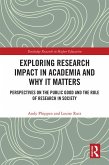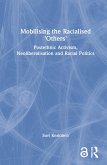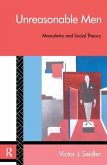- Gebundenes Buch
- Merkliste
- Auf die Merkliste
- Bewerten Bewerten
- Teilen
- Produkt teilen
- Produkterinnerung
- Produkterinnerung
The phrase 'LGBT community' is often used by policy-makers, service providers, and lesbian, gay, bisexual and trans people themselves, but what does it mean? What understandings and experiences does that term suggest, and ignore?
Andere Kunden interessierten sich auch für
![The Gay Science The Gay Science]() Kane RaceThe Gay Science197,99 €
Kane RaceThe Gay Science197,99 €![Exploring Autistic Sexualities, Relationality, and Genders Exploring Autistic Sexualities, Relationality, and Genders]() Exploring Autistic Sexualities, Relationality, and Genders200,99 €
Exploring Autistic Sexualities, Relationality, and Genders200,99 €![Rethinking Europe Rethinking Europe]() Gerard DelantyRethinking Europe197,99 €
Gerard DelantyRethinking Europe197,99 €![Exploring Research Impact in Academia and Why It Matters Exploring Research Impact in Academia and Why It Matters]() Andy PhippenExploring Research Impact in Academia and Why It Matters198,99 €
Andy PhippenExploring Research Impact in Academia and Why It Matters198,99 €![Exploring Sport and Leisure Disasters Exploring Sport and Leisure Disasters]() Hazel J HartleyExploring Sport and Leisure Disasters175,99 €
Hazel J HartleyExploring Sport and Leisure Disasters175,99 €![Mobilising the Racialised 'Others' Mobilising the Racialised 'Others']() Suvi KeskinenMobilising the Racialised 'Others'198,99 €
Suvi KeskinenMobilising the Racialised 'Others'198,99 €![Unreasonable Men Unreasonable Men]() Victor J SeidlerUnreasonable Men198,99 €
Victor J SeidlerUnreasonable Men198,99 €-
-
-
The phrase 'LGBT community' is often used by policy-makers, service providers, and lesbian, gay, bisexual and trans people themselves, but what does it mean? What understandings and experiences does that term suggest, and ignore?
Hinweis: Dieser Artikel kann nur an eine deutsche Lieferadresse ausgeliefert werden.
Hinweis: Dieser Artikel kann nur an eine deutsche Lieferadresse ausgeliefert werden.
Produktdetails
- Produktdetails
- Verlag: Taylor & Francis
- Seitenzahl: 228
- Erscheinungstermin: 1. Oktober 2017
- Englisch
- Abmessung: 234mm x 156mm x 14mm
- Gewicht: 499g
- ISBN-13: 9781138814004
- ISBN-10: 1138814008
- Artikelnr.: 43675281
- Herstellerkennzeichnung
- Libri GmbH
- Europaallee 1
- 36244 Bad Hersfeld
- gpsr@libri.de
- Verlag: Taylor & Francis
- Seitenzahl: 228
- Erscheinungstermin: 1. Oktober 2017
- Englisch
- Abmessung: 234mm x 156mm x 14mm
- Gewicht: 499g
- ISBN-13: 9781138814004
- ISBN-10: 1138814008
- Artikelnr.: 43675281
- Herstellerkennzeichnung
- Libri GmbH
- Europaallee 1
- 36244 Bad Hersfeld
- gpsr@libri.de
Eleanor Formby is Senior Research Fellow at the Centre for Education and Inclusion Research at Sheffield Hallam University, UK.
1. Introduction
Spatial communities and 'gay ghettos'
Cultural communities and practices
Imagined communities and the 'gay imaginary'
Friendships and personal communities
Virtual communities and cyberian mailways
Community is here to stay?
The research
The book
References
2. 'Owning' and questioning LGBT communities
Introduction
The acronym that 'lumps together'
'Managing' the acronym
Ambivalence
Commonality
Agency
Chapter summary
References
3. Diversity, inequality and prejudice amongst LGBT people
Introduction
Overview of existing literature
Diversity and inequality
Identity-based prejudice
Faith and religion
Parenting
(Non)conformity
Chapter summary
References
4. Lived experience and 'doing' community
Introduction
Overview of existing literature
Socialising, friendship and seeking intimacy
Friendship families
Safety in numbers
Accessing 'safe' spaces
Self-censorship
Activism
Lived experience across the life course
Chapter summary
References
5. Relationships to, within and beyond physical spaces
Introduction
Overview of existing literature
Physical space and geographical areas
Relocation
Rural living
Travel and tourism
Groups and services
Online spaces and virtual communities
Chapter summary
References
6. The pleasures and pains of scene spaces
Introduction
Overview of existing literature
The scene as 'community'
Positive experiences
Scene exclusions
Invasion, choice and ownership
Chapter summary
References
7. Pride spaces, rituals and symbols
Introduction
Overview of existing literature
Creating communities?
Safety and freedom
Celebration
Protest
Partying with politics
Commercialism
Alcohol at Pride events
Exclusion
'Excess' and 'extreme' displays of pride
Chapter summary
References
8. Imagined communities and a sense of belonging
Introduction
Overview of existing literature
Belonging and connection
Commonalities, similarities, and mutual understanding
Differences and values
Shared experiences and the 'bond' of discrimination?
Chapter summary
References
9. Consequences for wellbeing
Introduction
Overview of existing literature
Impacts on physical and mental health
Seeking support
Friendships, confidence and self-esteem
Finding people 'like me'
Alcohol, drugs and sex on the scene
Paradoxical spaces
Chapter summary
References
10. Conclusions and implications
References
Appendix: Research methods and participants
Research process and recruitment
Online survey
Interviews and group discussions
Participants
References
Spatial communities and 'gay ghettos'
Cultural communities and practices
Imagined communities and the 'gay imaginary'
Friendships and personal communities
Virtual communities and cyberian mailways
Community is here to stay?
The research
The book
References
2. 'Owning' and questioning LGBT communities
Introduction
The acronym that 'lumps together'
'Managing' the acronym
Ambivalence
Commonality
Agency
Chapter summary
References
3. Diversity, inequality and prejudice amongst LGBT people
Introduction
Overview of existing literature
Diversity and inequality
Identity-based prejudice
Faith and religion
Parenting
(Non)conformity
Chapter summary
References
4. Lived experience and 'doing' community
Introduction
Overview of existing literature
Socialising, friendship and seeking intimacy
Friendship families
Safety in numbers
Accessing 'safe' spaces
Self-censorship
Activism
Lived experience across the life course
Chapter summary
References
5. Relationships to, within and beyond physical spaces
Introduction
Overview of existing literature
Physical space and geographical areas
Relocation
Rural living
Travel and tourism
Groups and services
Online spaces and virtual communities
Chapter summary
References
6. The pleasures and pains of scene spaces
Introduction
Overview of existing literature
The scene as 'community'
Positive experiences
Scene exclusions
Invasion, choice and ownership
Chapter summary
References
7. Pride spaces, rituals and symbols
Introduction
Overview of existing literature
Creating communities?
Safety and freedom
Celebration
Protest
Partying with politics
Commercialism
Alcohol at Pride events
Exclusion
'Excess' and 'extreme' displays of pride
Chapter summary
References
8. Imagined communities and a sense of belonging
Introduction
Overview of existing literature
Belonging and connection
Commonalities, similarities, and mutual understanding
Differences and values
Shared experiences and the 'bond' of discrimination?
Chapter summary
References
9. Consequences for wellbeing
Introduction
Overview of existing literature
Impacts on physical and mental health
Seeking support
Friendships, confidence and self-esteem
Finding people 'like me'
Alcohol, drugs and sex on the scene
Paradoxical spaces
Chapter summary
References
10. Conclusions and implications
References
Appendix: Research methods and participants
Research process and recruitment
Online survey
Interviews and group discussions
Participants
References
1. Introduction
Spatial communities and 'gay ghettos'
Cultural communities and practices
Imagined communities and the 'gay imaginary'
Friendships and personal communities
Virtual communities and cyberian mailways
Community is here to stay?
The research
The book
References
2. 'Owning' and questioning LGBT communities
Introduction
The acronym that 'lumps together'
'Managing' the acronym
Ambivalence
Commonality
Agency
Chapter summary
References
3. Diversity, inequality and prejudice amongst LGBT people
Introduction
Overview of existing literature
Diversity and inequality
Identity-based prejudice
Faith and religion
Parenting
(Non)conformity
Chapter summary
References
4. Lived experience and 'doing' community
Introduction
Overview of existing literature
Socialising, friendship and seeking intimacy
Friendship families
Safety in numbers
Accessing 'safe' spaces
Self-censorship
Activism
Lived experience across the life course
Chapter summary
References
5. Relationships to, within and beyond physical spaces
Introduction
Overview of existing literature
Physical space and geographical areas
Relocation
Rural living
Travel and tourism
Groups and services
Online spaces and virtual communities
Chapter summary
References
6. The pleasures and pains of scene spaces
Introduction
Overview of existing literature
The scene as 'community'
Positive experiences
Scene exclusions
Invasion, choice and ownership
Chapter summary
References
7. Pride spaces, rituals and symbols
Introduction
Overview of existing literature
Creating communities?
Safety and freedom
Celebration
Protest
Partying with politics
Commercialism
Alcohol at Pride events
Exclusion
'Excess' and 'extreme' displays of pride
Chapter summary
References
8. Imagined communities and a sense of belonging
Introduction
Overview of existing literature
Belonging and connection
Commonalities, similarities, and mutual understanding
Differences and values
Shared experiences and the 'bond' of discrimination?
Chapter summary
References
9. Consequences for wellbeing
Introduction
Overview of existing literature
Impacts on physical and mental health
Seeking support
Friendships, confidence and self-esteem
Finding people 'like me'
Alcohol, drugs and sex on the scene
Paradoxical spaces
Chapter summary
References
10. Conclusions and implications
References
Appendix: Research methods and participants
Research process and recruitment
Online survey
Interviews and group discussions
Participants
References
Spatial communities and 'gay ghettos'
Cultural communities and practices
Imagined communities and the 'gay imaginary'
Friendships and personal communities
Virtual communities and cyberian mailways
Community is here to stay?
The research
The book
References
2. 'Owning' and questioning LGBT communities
Introduction
The acronym that 'lumps together'
'Managing' the acronym
Ambivalence
Commonality
Agency
Chapter summary
References
3. Diversity, inequality and prejudice amongst LGBT people
Introduction
Overview of existing literature
Diversity and inequality
Identity-based prejudice
Faith and religion
Parenting
(Non)conformity
Chapter summary
References
4. Lived experience and 'doing' community
Introduction
Overview of existing literature
Socialising, friendship and seeking intimacy
Friendship families
Safety in numbers
Accessing 'safe' spaces
Self-censorship
Activism
Lived experience across the life course
Chapter summary
References
5. Relationships to, within and beyond physical spaces
Introduction
Overview of existing literature
Physical space and geographical areas
Relocation
Rural living
Travel and tourism
Groups and services
Online spaces and virtual communities
Chapter summary
References
6. The pleasures and pains of scene spaces
Introduction
Overview of existing literature
The scene as 'community'
Positive experiences
Scene exclusions
Invasion, choice and ownership
Chapter summary
References
7. Pride spaces, rituals and symbols
Introduction
Overview of existing literature
Creating communities?
Safety and freedom
Celebration
Protest
Partying with politics
Commercialism
Alcohol at Pride events
Exclusion
'Excess' and 'extreme' displays of pride
Chapter summary
References
8. Imagined communities and a sense of belonging
Introduction
Overview of existing literature
Belonging and connection
Commonalities, similarities, and mutual understanding
Differences and values
Shared experiences and the 'bond' of discrimination?
Chapter summary
References
9. Consequences for wellbeing
Introduction
Overview of existing literature
Impacts on physical and mental health
Seeking support
Friendships, confidence and self-esteem
Finding people 'like me'
Alcohol, drugs and sex on the scene
Paradoxical spaces
Chapter summary
References
10. Conclusions and implications
References
Appendix: Research methods and participants
Research process and recruitment
Online survey
Interviews and group discussions
Participants
References

